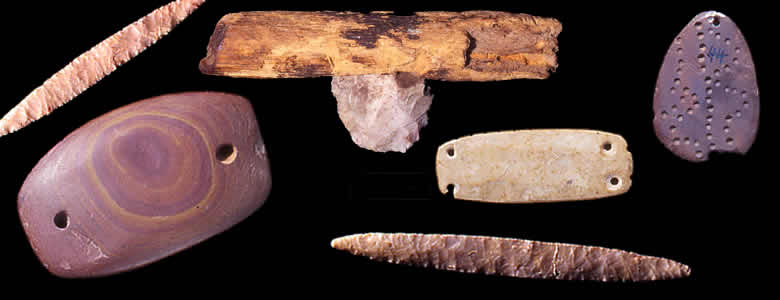
Texas Indians created a great variety of stone tools and ornaments using many of the diverse rocks they found throughout the state and sometimes materials traded from distant sources. While much attention has been placed on projectile points—"arrowheads" including dart points and true arrow points—many of the other kinds of stone artifacts are not well known. This exhibit presents a photo gallery introducing many of the kinds of stone artifacts that archeologists have identified—almost everything except projectile points.
The featured images were assembled in July 1999 for a workshop on lithic (stone) artifacts sponsored by the Stewards Program of the Texas Historical Commission (THC). Many of the artifacts were brought to the meeting, so that the Stewards—avocational archeologists who assist the THC in monitoring, recording, and preserving archeological sites across the state—could get hands-on knowledge of some of the artifact groups. This photo gallery is presented at the suggestion of a number of the Stewards who thought these images ought to be posted on the Internet for future reference.
Raw Material
The raw material categories illustrated in these photos are described in informal terms; other archeologists often have different names for the raw material sources or other views on the material's distribution. The best reference for raw materials in the Texas area is Dr. Larry Banks' (1990) From Mountain Peaks to Alligator Stomachs: A Review of Lithic Sources in the Trans-Mississippi South, the Southern Plains, and Adjacent Southwest (Oklahoma Anthropological Society, Memoir No. 4). Unfortunately, this study has been out of print for several years and may be difficult to find. Where possible, I have keyed the descriptions below to Dr. Banks' monograph. And, the raw material categories shown here are selective and do not represent the full range of raw materials from which stone tools were made in Texas.
The basic techniques of stone-tool making are beyond the scope of this exhibit but can be found in a variety of published sources and on various Web sites. The nature of the raw material often affected the reduction techniques used. For example, Uvalde gravels (cobbles from ancient stream deposits that are found today on hilltops and elsewhere across much of the southern half of Texas) were often worked by percussion and pressure techniques: percussion to shape and pressure to finish. Cobbles or blanks were often "heat-treated" or thermally altered prior to being worked. It is also thought that some of the coarse pebbles and petrified wood available to the Indians of eastern Texas were reduced through a technique known as bipolar reduction (see Anvil Stones below) using a hammerstone to smash a cobble resting on another stone surface.
Where possible, data are provided on the function of specific tool categories. Today "use-wear" studies are being conducted on many types of stone tools. But this is no easy thing—to determine what an artifact was used for requires extensive experimentation and the use of high-power microscopy. When use-wear experts look at multiple examples of one type of tool, they often see a range of use-wear traces including polish, striations, and several kinds of edge damage. These diverse patterns suggest that some tool types were used for many different tasks. This, of course, is to be expected—after all, think of the tasks for which we use screwdrivers. A good example of use-wear research is a 1997 study by Dale Hudler, Determining Clear Fork Function Through Use-Wear Analysis.
Time Frames
The time frame or chronology noted in some of the discussions (for example, "Late Archaic") is a broadly generalized one drawn largely from Stone Artifacts of Texas Indians by Ellen Sue Turner and myself (1999) and can be briefly summarized as follows:
Paleoindian (11,500-8000 years ago)
Early Archaic (8000-4500 years ago)
Middle Archaic (4500-3000 years ago)
Late Archaic and Transitional Archaic (3000-1300 years ago)
Late Prehistoric (1300-300 years ago)